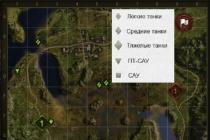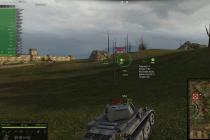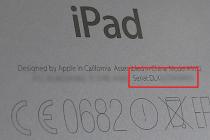The proposed instruction for sewing machines Chaika and Podolsk is a simplified version of the manufacturer's instruction manual. This universal instruction can be used for all models of sewing machines Chaika 2, 3, 132, 132m, 134, and Podolsk 142, 142m, Malva and other models.
1. Main components and mechanisms

Remove the top cover (two screws on the top of the cover) and apply a few drops of oil to the main components of the front compartment. Screw 1 is for adjusting the needle bar into which the needle is inserted. Screw 2 clamps the upper thread tensioner. This mount often needs to be tightened, since the plastic body of the tensioner falls through the screw and the tensioner begins to wobble in the seat.

If the fabric does not advance well, most often you just need to raise the teeth of the rail by setting the switch to position (H) - normal, B - embroidery.

When removing the flywheel, be sure to pay attention to the position of the friction washer tabs (L). To completely loosen the friction screw holding the flywheel, loosen the screw (K). Adjusting the tension of the electric drive belt or is carried out after loosening the screw (B).

The bobbin winder also needs to be lubricated and sometimes adjusted.
2. Incorrectly selected needle number leads to thread breakage

Any instruction has recommendations for choosing a needle, depending on the type and thickness of the fabric and the selected threads. Here is a list of recommendations for the sewing machine Chaika, Podolskaya:
Silk, cambric - No. 70; chintz, satin, cambric, linen fabrics - No. 80;
cotton fabrics, coarse calico, flannel, thin woolen fabrics - No. 90;
woolen, costume fabrics - No. 100;
thick woolen fabrics, broadcloth - No. 110.
The needle must be installed up to the stop and tightened well with a screw so that it does not jump out during operation. The flat (sawn) side of the bulb on the needle should be facing away from you. And do not install industrial design needles with a round bulb. Such needles lead to skips and even to serious breakages, in particular breakage of the sewing machine needle.


Before threading the lower thread, you need to turn the handwheel to put the needle in the upper position, pull out the needle plate and grab the latch of the bobbin case with two fingers of your left hand to pull it out of the shuttle of the machine. By the way, when you install it back, a faint click should be heard. If the latch does not work, then the bobbin case may turn on the axis and break the needle.
The thread is brought under the spring plate of the cap, which creates tension in the lower thread. The tension is regulated by a screw pressing this plate. By turning the screw to the left, the tension is loosened, and vice versa. Only unscrew no more than half a turn, otherwise the screw may pop out and be lost.
The bottom thread should come out freely without effort, but with a slight perceptible tension. The lower thread tension is rarely adjusted. Basically, it needs to be changed when sewing too thin fabrics or knitwear, as well as when using very thin threads.
4. Control of the sewing machine Chaika, Podolsk

Often the bobbin case of the Seagull sewing machine is called a shuttle or a bobbin. This is wrong, every detail has its own name.

To sew a normal straight stitch, the zigzag width lever must be set to the number "0" and the position of the stitch selection switch should be set to the straight stitch. Set the desired stitch length, usually 3 or 4 mm, thread correctly. The shuttle course consists of a shuttle and a bobbin case. The bobbin with lower thread is inserted into the bobbin case.
Before starting work, check the position of the rack teeth. For sewing medium fabrics, the selector lever should be in the "H" position - normal. "B" - embroidery, that is, the teeth of the rail during the operation of the sewing machine should not come out of the needle plate and not advance the fabric. "SH" - silk, thin fabrics.
The guideline for the correct position of the rack teeth is the position of these letters on top.
To sew a zigzag stitch, set the zigzag width to "0 - 5" and select zigzag on the stitch selector. Do not forget to reduce the stitch length to 1 - 3 mm, otherwise the zigzag will be too sparse.

The tension of the threads when performing a zigzag stitch needs to be adjusted additionally. Adjust the upper thread tension so that both threads are pulled evenly into the fabric. Please note that too much tension on the top thread will cause the fabric to pull when sewing. You may also need to adjust the bobbin thread tension.

The signature sound of the Seagull sewing machine occurs at the knot (L). The bevel gear during operation periodically touches the frame of the machine. Theoretically, knocking can be eliminated, but only the master can do this. However, you can reduce the noise of this assembly yourself if you lubricate the gear teeth with a thick lubricant, such as graphite grease.

Depending on the operating conditions of the sewing machine, lubrication and cleaning should be done periodically, but at least once every six months. Oil for lubrication should only be used special, designed for lubricating sewing machines. Other types of oils can cause heavy running.

Half of sewing machine malfunctions begin due to improper care of the sewing machine. The most common case is when, after a year, the machine is taken out of the pantry and it turns out that it makes passes, breaks the thread, etc. But before there were no complaints about her work. Why this happens, you will learn in the article.

Factory instructions for Chaika contains several pages on how to lubricate the machine. In fact, these recommendations can be simplified and only those places where there is friction of metal parts can be lubricated.
To have access to some nodes, you need to remove the top cover of the machine, reinforced with two screws and the bottom protection (plywood), fixed to the wooden case with 4 petals. Do not get carried away with abundant lubrication, especially around the needle. If you do not want to eventually get an unpleasant oil stain when sewing, then 2-3 drops of oil are enough to lubricate one node in this compartment.

To clean the shuttle and the shuttle compartment, it is convenient to use a hard glue brush, and for lubrication - a regular medical syringe.
This article lists the main malfunctions of sewing machines such as Chaika, Podolsk and how to fix them. Using this material, you can repair sewing machines of other brands, including foreign-made household sewing machines with a vertical shuttle. If you have a manual for a sewing machine, be sure to carefully read the manufacturer's recommendations for the operation and care of the sewing machine.
How is the vertical shuttle. Possible malfunctions and ways to eliminate them. Shuttle of the sewing machine type Seagull.
Basic knowledge of how the sewing machine works and how to set up your sewing machine can be found in the instructions for the sewing machine. If you want to understand in more detail how the sewing machine works, and how to make minor repairs to the Podolsk manual sewing machine on your own, then this article can become your first assistant, where brief instructions for repairing it are given.
Repairing a sewing machine Seagull requires certain knowledge and experience. But, many types of "breakdowns" can be fixed on your own if you read this article. In this article, we offer a brief, written in a simple and understandable language, instructions for sewing machines such as Seagull that perform a zigzag stitch. The operation and arrangement of the sewing machine Podolsk and Chaika are almost the same. Therefore, this instruction manual can be used for any models of Chaika, Malva, Podolsk sewing machines.
Any manual for a sewing machine pays considerable attention to the bobbin, a small but important part of the sewing machine. How to wind the thread correctly, how to insert the bobbin into the bobbin case, which threads can be used and which bobbins are suitable for your sewing machine model. Read your sewing machine manual carefully. It provides important information that will keep your machine sewing flawlessly for many years to come.
Many have preserved such sewing machines. They have long been outdated, but they are quite suitable for learning the basics of sewing. It is best for a beginner seamstress to use a hand-operated machine. But, as a rule, a manual drive requires serious repairs over many years of operation. How to do this, read this article.
To understand how any lockstitch sewing machine works, first study how a lockstitch is formed. This will give you an idea of which parts of the sewing machine interact with each other to form a quality, skip-free stitch in the line.
The Seagull sewing machine performs a straight line, a zigzag line and, based on it, several types of finishing lines. In our time, you can buy such a machine only with an electric drive (with a pedal), a foot model (with a belt), the so-called "cabinet", was produced in Soviet times.
Sewing machine Seagull 2; 3; 142m; 132; 134; 143; Podolsk 142, Podolsk 125-1; Malva and others - all these machines have the same device and instructions for use and setup. They have practically no structural differences, except that there is an additional set of types of decorative zigzag stitches. True, when repairs and adjustments are being made, for each model of the Chaika or Podolsk sewing machine, it is required to know the corresponding parameters, the configuration schemes for the shuttle assembly of each model. This is one of the disadvantages, but the big advantage is that the price of spare parts, especially used ones for Chaika-type sewing machines, is quite acceptable.
Before you start setting up the Chaika sewing machine on your own, it is advisable to do a routine inspection, cleaning, lubrication. To do this, disconnect the electric motor from the mains, remove the top cover (it is fastened with two screws). Detach the presser foot, remove the needle and needle plate, bobbin cover. Detach the machine from the wooden stand or table. Disassemble the shuttle: bobbin case, locking ring, shuttle. Now remove dust, dirt, lint from the machine (especially in the shuttle compartment) and lubricate all rubbing, accessible places well with machine oil.
As a rule, the main malfunctions of Chaika-type sewing machines are thread breakage during sewing; skipped stitches; looping of the upper thread in the line. There is also a characteristic knock during operation, but this is a design feature of these machines and the only remedy is periodic lubrication. Although there are exceptions, and Seagull sewing machines work quite softly.
Thread break. The first reason leading to thread breakage is the bent point of a blunt needle, which breaks the thread during its movement. With the help of a magnifying glass, the state of the needle point is very clearly visible. Use serviceable needles and designed for Chaika sewing machines, in accordance with the instructions.
The question is often asked: how to insert a thread into a needle in a Seagull sewing machine? For all Chaika-type machines, and for most others that perform a zigzag stitch, the needle is placed with the sawn-off part of the flask away from you, and the groove for the thread should look at you. It is from the side of this groove that the thread is inserted.
If the needle touches it when entering the needle hole, then periodically the thread will break. When performing a straight stitch, the needle should be located in the center of the hole in the needle plate, evenly removed from its sides, and when performing a zigzag operation, the distance L should be the same with R. The longitudinal installation of the needle in the center of the needle gap is carried out by shifting the needle bar frame, fixed with two screws on the rocker arm located at the top of the machine (turn the flywheel on the zigzag line and you will see this mount). Loosen these screws and set the needle exactly in the center on a straight stitch (offsetting the needle bar frame).
Then check the position of the needle for the left and right injection. I hope that the needle entry (at the maximum zigzag width on the right and left) will be evenly removed from the center. If the needle touches the edge of the hole at the maximum width of the zigzag, then contact the master, this case is already for him.

The transverse position of the needle is regulated by a rod fixed on a plate with two screws, and a plate pressing the needle bar frame to the bracket rod. Adjusting this assembly is quite complicated and requires experience, but, unfortunately, it is this mechanism that can spontaneously go astray during operation, especially the Chaika electric sewing machine. Therefore, if you decide to repair your sewing machine yourself, you should learn how to adjust the position of the needle, since moving it forward is the cause of its breakdown, and moving towards the seamstress is the cause of skipped stitches in the line.
Adjusting the needle position requires professional knowledge and experience. If you are not sure that you can do it yourself, contact the master, as it may cause misalignment of other components, the repair of which cannot be learned from a boring book stuffed with technical terms and diagrams.
It can be added that when using a curved needle, notches may form on the nose of the hook, which “unwind” the thread and break. It should be perfectly smooth and sharp, without roughness. Its condition can be determined by running a fingernail along the edge of the spout or using a magnifying glass.
The pressure plate tightening screw must not be serrated, the latch handle must be clearly fixed and its surface must be clean and smooth.
Incorrect position of the shuttle nose of Chaika sewing machines leads to thread breakage and the appearance of other stitching defects, including skips. Passes usually appear due to the wrong position of the shuttle at the moment of meeting with the needle. The nose of the shuttle does not capture the loop formed, passes by and a gap is formed. Many other factors can be the reason.
Overlock class 51 is perhaps the most common brand of industrial sewing machine used in everyday life, in small studios.
It is not always necessary to repair overlocks or adjust them, sometimes it is enough just to adjust the thread tension and it will again overcast the fabric with high quality.
Although the Soviet-made Chaika sewing machine is famous for its reliability, yet every owner of such rare equipment will certainly have to understand, at least in general terms, that Chaika repair is included. These sewing machines sew perfectly, but subject to regular maintenance. Moreover, having understood the device and the principle of operation, the repair of Seagull sewing machines will not be very difficult.
The main malfunction of Seagull sewing machines is skipped stitches, looping of the lower or upper thread, its breakage. However, it is best to start not with the problem itself, but with a routine inspection, cleaning and lubrication.
- To do this, disconnect the electric motor from the mains, remove the top cover by unscrewing the two fixing screws.
- Next, you need to disconnect the foot, remove the needle, needle plate, and also the cover of the shuttle mechanism.
- The machine itself must be disconnected from the wooden stand, disassemble the shuttle.
- And now you can clean the machine from dust, dirt, tow.
- After that, using a conventional medical syringe, you can fill in all the rubbing parts and lubricate all accessible places well.
After carrying out all the preparatory measures (in principle, this is nothing more than), you can proceed directly to the repair: identifying the causes of the breakdown and eliminating them.
Thread breakage in sewing machines Seagull can occur due to the bent point of a blunt needle. It is easy to see this under a magnifying glass.

When operating Chaika sewing machines, it is advisable to use serviceable needles and designed specifically for this model in accordance with the instructions.
Also, the thread may break due to the fact that the needle may touch it when entering the needle hole. You can install it in the center of the needle gap by moving the needle bar frame, which is fixed with screws on the rocker. This will be the repair.
Repair of sewing machines Seagull in the workshop
When using the Chaika 123 M sewing machine, repairs are not always easy and possible at home. Adjustment, adjustment and repair of some mechanisms may require the experience and professionalism of specialists.For example, if during work the transverse position of the needle spontaneously went astray (which happens quite often in Chaika sewing machines), then it would most likely be better for the master to carry out the repair. This failure may be the cause of misalignment of some other nodes.
It will not be superfluous to study for breakdowns.
There are also many other settings that are quite difficult to repair on your own. This is, for example, the repair of the shuttle. It is there that the causes of looping can be hidden.
For almost every model of the Seagull sewing machine, engineers have developed their own features for setting up and repairing this unit. Therefore, it is better to entrust such delicate work to a sewing equipment repair specialist.
The proposed instruction for sewing machines Chaika and Podolsk is a simplified version of the manufacturer's instruction manual. This universal instruction can be used for all models of sewing machines Chaika 2, 3, 132, 132m, 134, and Podolsk 142, 142m, Malva and other models.
1. Main components and mechanisms

Remove the top cover (two screws on the top of the cover) and apply a few drops of oil to the main components of the front compartment. Screw 1 is for adjusting the needle bar into which the needle is inserted. Screw 2 clamps the upper thread tensioner. This mount often needs to be tightened, since the plastic body of the tensioner falls through the screw and the tensioner begins to wobble in the seat.

If the fabric does not advance well, most often you just need to raise the teeth of the rail by setting the switch to position (H) - normal, B - embroidery.

When removing the flywheel, be sure to pay attention to the position of the friction washer tabs (L). To completely loosen the friction screw holding the flywheel, loosen the screw (K). Adjusting the tension of the electric drive belt or is carried out after loosening the screw (B).

The bobbin winder also needs to be lubricated and sometimes adjusted.
2. Incorrectly selected needle number leads to thread breakage

Any instruction has recommendations for choosing a needle, depending on the type and thickness of the fabric and the selected threads. Here is a list of recommendations for the sewing machine Chaika, Podolskaya:
Silk, cambric - No. 70; chintz, satin, cambric, linen fabrics - No. 80;
cotton fabrics, coarse calico, flannel, thin woolen fabrics - No. 90;
woolen, costume fabrics - No. 100;
thick woolen fabrics, broadcloth - No. 110.
The needle must be installed up to the stop and tightened well with a screw so that it does not jump out during operation. The flat (sawn) side of the bulb on the needle should be facing away from you. And do not install industrial design needles with a round bulb. Such needles lead to skips and even to serious breakages, in particular breakage of the sewing machine needle.


Before threading the lower thread, you need to turn the handwheel to put the needle in the upper position, pull out the needle plate and grab the latch of the bobbin case with two fingers of your left hand to pull it out of the shuttle of the machine. By the way, when you install it back, a faint click should be heard. If the latch does not work, then the bobbin case may turn on the axis and break the needle.
The thread is brought under the spring plate of the cap, which creates tension in the lower thread. The tension is regulated by a screw pressing this plate. By turning the screw to the left, the tension is loosened, and vice versa. Only unscrew no more than half a turn, otherwise the screw may pop out and be lost.
The bottom thread should come out freely without effort, but with a slight perceptible tension. The lower thread tension is rarely adjusted. Basically, it needs to be changed when sewing too thin fabrics or knitwear, as well as when using very thin threads.
4. Control of the sewing machine Chaika, Podolsk

Often the bobbin case of the Seagull sewing machine is called a shuttle or a bobbin. This is wrong, every detail has its own name.

To sew a normal straight stitch, the zigzag width lever must be set to the number "0" and the position of the stitch selection switch should be set to the straight stitch. Set the desired stitch length, usually 3 or 4 mm, thread correctly. The shuttle course consists of a shuttle and a bobbin case. The bobbin with lower thread is inserted into the bobbin case.
Before starting work, check the position of the rack teeth. For sewing medium fabrics, the selector lever should be in the "H" position - normal. "B" - embroidery, that is, the teeth of the rail during the operation of the sewing machine should not come out of the needle plate and not advance the fabric. "SH" - silk, thin fabrics.
The guideline for the correct position of the rack teeth is the position of these letters on top.
To sew a zigzag stitch, set the zigzag width to "0 - 5" and select zigzag on the stitch selector. Do not forget to reduce the stitch length to 1 - 3 mm, otherwise the zigzag will be too sparse.

The tension of the threads when performing a zigzag stitch needs to be adjusted additionally. Adjust the upper thread tension so that both threads are pulled evenly into the fabric. Please note that too much tension on the top thread will cause the fabric to pull when sewing. You may also need to adjust the bobbin thread tension.

The signature sound of the Seagull sewing machine occurs at the knot (L). The bevel gear during operation periodically touches the frame of the machine. Theoretically, knocking can be eliminated, but only the master can do this. However, you can reduce the noise of this assembly yourself if you lubricate the gear teeth with a thick lubricant, such as graphite grease.

Depending on the operating conditions of the sewing machine, lubrication and cleaning should be done periodically, but at least once every six months. Oil for lubrication should only be used special, designed for lubricating sewing machines. Other types of oils can cause heavy running.

Half of sewing machine malfunctions begin due to improper care of the sewing machine. The most common case is when, after a year, the machine is taken out of the pantry and it turns out that it makes passes, breaks the thread, etc. But before there were no complaints about her work. Why this happens, you will learn in the article.

Factory instructions for Chaika contains several pages on how to lubricate the machine. In fact, these recommendations can be simplified and only those places where there is friction of metal parts can be lubricated.
To have access to some nodes, you need to remove the top cover of the machine, reinforced with two screws and the bottom protection (plywood), fixed to the wooden case with 4 petals. Do not get carried away with abundant lubrication, especially around the needle. If you do not want to eventually get an unpleasant oil stain when sewing, then 2-3 drops of oil are enough to lubricate one node in this compartment.

To clean the shuttle and the shuttle compartment, it is convenient to use a hard glue brush, and for lubrication - a regular medical syringe.
Sewing machine Seagull 142m - Perpetuum mobile.
Advantages:
Large range of actions, easy to use.
Flaws:
The sewing machine Chaika 142m was bought by my parents in 1991, so at the moment she is already 23 years old, or rather 23 and a half. The machine still works great. Only this summer I had to change the belt, as frayed from old age. But I quickly eliminated this reason, because the belts are sold in stores and have one size for almost all sewing machines. It cost 150 rubles and did not affect the budget in any way. It was the only thing in this machine that should have been replaced in 23 years. Therefore, I call this machine a perpetual motion machine, as it works properly and does not require any investments. Just a dream, not a machine!
The sewing machine Chaika 142m is built-in and does not take up much space if you put something on it. I have flowers on my typewriter, that is, it serves as a table, quite conveniently. 


The machine is very easy to disassemble. It is enough to open the door, tip the countertop onto it and get the machine.
The sewing machine Chaika 142m has 2 foot pedals. One pedal is electric and the other is normal. But I'm used to using only electric, it's much more convenient and faster.
The electric pedal is made of black plastic. It has a wire that connects to the machine itself and to the outlet. Easily detaches from the wires, so it makes it easier to store. 


~ CONTROLS AND COMPONENTS OF THE MACHINE ~

1. Sliding plate.
2. Presser foot.
3. Presser foot screw.
4. Thread guide.
5. Needle plate fixing screw.
6. Upper thread tension regulator.
7. Thread take-up.
8. Thread guide.
9. Winder tension unit.
10. Top cover fixing screw.
11. Rod for the coil.
12. Stitch type selection knob.
13. Zigzag width indicator.
14. Rod for the coil.
15. Winder.
16. Flywheel.
17. Needle shift knob left and right.
18. Belt.
19. Zigzag width adjustment knob.
20. Reverse feed lever.
21. Stitch length knob.
22. Stitch length indicator.
23. Platform.
24. Spool of thread.
25. Bobbin.
The sewing machine is very easy to operate and it will not be difficult to prepare it for work.
To begin with, I will show and tell you how to wind the threads on the bobbin.
The proposed instruction for sewing machines Chaika and Podolsk is a simplified version of the manufacturer's instruction manual. This universal instruction can be used for all models of sewing machines Chaika 2, 3, 132, 132m, 134, and Podolsk 142, 142m, Malva and other models.
1. Main components and mechanisms

Remove the top cover (two screws on the top of the cover) and apply a few drops of oil to the main components of the front compartment. Screw 1 is for adjusting the needle bar into which the needle is inserted. Screw 2 clamps the upper thread tensioner. This mount often needs to be tightened, since the plastic body of the tensioner falls through the screw and the tensioner begins to wobble in the seat.

If the fabric does not advance well, most often you just need to raise the teeth of the rail by setting the switch to position (H) - normal, B - embroidery.

When removing the flywheel, be sure to pay attention to the position of the friction washer tabs (L). To completely loosen the friction screw holding the flywheel, loosen the screw (K). Adjusting the tension of the electric drive belt or is carried out after loosening the screw (B).

The bobbin winder also needs to be lubricated and sometimes adjusted.
2. Incorrectly selected needle number leads to thread breakage

Any instruction has recommendations for choosing a needle, depending on the type and thickness of the fabric and the selected threads. Here is a list of recommendations for the sewing machine Chaika, Podolskaya:
Silk, cambric - No. 70; chintz, satin, cambric, linen fabrics - No. 80;
cotton fabrics, coarse calico, flannel, thin woolen fabrics - No. 90;
woolen, costume fabrics - No. 100;
thick woolen fabrics, broadcloth - No. 110.
The needle must be installed up to the stop and tightened well with a screw so that it does not jump out during operation. The flat (sawn) side of the bulb on the needle should be facing away from you. And do not install industrial design needles with a round bulb. Such needles lead to skips and even to serious breakages, in particular breakage of the sewing machine needle.


Before threading the lower thread, you need to turn the handwheel to put the needle in the upper position, pull out the needle plate and grab the latch of the bobbin case with two fingers of your left hand to pull it out of the shuttle of the machine. By the way, when you install it back, a faint click should be heard. If the latch does not work, then the bobbin case may turn on the axis and break the needle.
The thread is brought under the spring plate of the cap, which creates tension in the lower thread. The tension is regulated by a screw pressing this plate. By turning the screw to the left, the tension is loosened, and vice versa. Only unscrew no more than half a turn, otherwise the screw may pop out and be lost.
The bottom thread should come out freely without effort, but with a slight perceptible tension. The lower thread tension is rarely adjusted. Basically, it needs to be changed when sewing too thin fabrics or knitwear, as well as when using very thin threads.
4. Control of the sewing machine Chaika, Podolsk

Often the bobbin case of the Seagull sewing machine is called a shuttle or a bobbin. This is wrong, every detail has its own name.

To sew a normal straight stitch, the zigzag width lever must be set to the number "0" and the position of the stitch selection switch should be set to the straight stitch. Set the desired stitch length, usually 3 or 4 mm, thread correctly. The shuttle course consists of a shuttle and a bobbin case. The bobbin with lower thread is inserted into the bobbin case.
Before starting work, check the position of the rack teeth. For sewing medium fabrics, the selector lever should be in the "H" position - normal. "B" - embroidery, that is, the teeth of the rail during the operation of the sewing machine should not come out of the needle plate and not advance the fabric. "SH" - silk, thin fabrics.
The guideline for the correct position of the rack teeth is the position of these letters on top.
To sew a zigzag stitch, set the zigzag width to "0 - 5" and select zigzag on the stitch selector. Do not forget to reduce the stitch length to 1 - 3 mm, otherwise the zigzag will be too sparse.

The tension of the threads when performing a zigzag stitch needs to be adjusted additionally. Adjust the upper thread tension so that both threads are pulled evenly into the fabric. Please note that too much tension on the top thread will cause the fabric to pull when sewing. You may also need to adjust the bobbin thread tension.

The signature sound of the Seagull sewing machine occurs at the knot (L). The bevel gear during operation periodically touches the frame of the machine. Theoretically, knocking can be eliminated, but only the master can do this. However, you can reduce the noise of this assembly yourself if you lubricate the gear teeth with a thick lubricant, such as graphite grease.

Depending on the operating conditions of the sewing machine, lubrication and cleaning should be done periodically, but at least once every six months. Oil for lubrication should only be used special, designed for lubricating sewing machines. Other types of oils can cause heavy running.

Half of sewing machine malfunctions begin due to improper care of the sewing machine. The most common case is when, after a year, the machine is taken out of the pantry and it turns out that it makes passes, breaks the thread, etc. But before there were no complaints about her work. Why this happens, you will learn in the article.

Factory instructions for Chaika contains several pages on how to lubricate the machine. In fact, these recommendations can be simplified and only those places where there is friction of metal parts can be lubricated.
To have access to some nodes, you need to remove the top cover of the machine, reinforced with two screws and the bottom protection (plywood), fixed to the wooden case with 4 petals. Do not get carried away with abundant lubrication, especially around the needle. If you do not want to eventually get an unpleasant oil stain when sewing, then 2-3 drops of oil are enough to lubricate one node in this compartment.

To clean the shuttle and the shuttle compartment, it is convenient to use a hard glue brush, and for lubrication - a regular medical syringe.
Sewing machine Seagull 142m - Perpetuum mobile.
Advantages:
Large range of actions, easy to use.
Flaws:
The sewing machine Chaika 142m was bought by my parents in 1991, so at the moment she is already 23 years old, or rather 23 and a half. The machine still works great. Only this summer I had to change the belt, as frayed from old age. But I quickly eliminated this reason, because the belts are sold in stores and have one size for almost all sewing machines. It cost 150 rubles and did not affect the budget in any way. It was the only thing in this machine that should have been replaced in 23 years. Therefore, I call this machine a perpetual motion machine, as it works properly and does not require any investments. Just a dream, not a machine!
The sewing machine Chaika 142m is built-in and does not take up much space if you put something on it. I have flowers on my typewriter, that is, it serves as a table, quite conveniently. 


The machine is very easy to disassemble. It is enough to open the door, tip the countertop onto it and get the machine.
The sewing machine Chaika 142m has 2 foot pedals. One pedal is electric and the other is normal. But I'm used to using only electric, it's much more convenient and faster.
The electric pedal is made of black plastic. It has a wire that connects to the machine itself and to the outlet. Easily detaches from the wires, so it makes it easier to store. 


~ CONTROLS AND COMPONENTS OF THE MACHINE ~

1. Sliding plate.
2. Presser foot.
3. Presser foot screw.
4. Thread guide.
5. Needle plate fixing screw.
6. Upper thread tension regulator.
7. Thread take-up.
8. Thread guide.
9. Winder tension unit.
10. Top cover fixing screw.
11. Rod for the coil.
12. Stitch type selection knob.
13. Zigzag width indicator.
14. Rod for the coil.
15. Winder.
16. Flywheel.
17. Needle shift knob left and right.
18. Belt.
19. Zigzag width adjustment knob.
20. Reverse feed lever.
21. Stitch length knob.
22. Stitch length indicator.
23. Platform.
24. Spool of thread.
25. Bobbin.
The sewing machine is very easy to operate and it will not be difficult to prepare it for work.
To begin with, I will show and tell you how to wind the threads on the bobbin.
First you need to turn the car on idle. To do this, loosen the screw by turning it counterclockwise.














